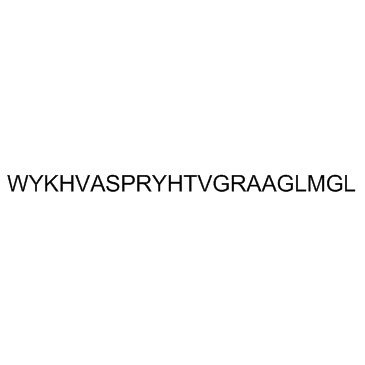| Description |
Neuropeptide W-23(human), the active form of Neuropeptide W, is an endogenous ligand for NPBW1 and NPBW2.
|
| Related Catalog |
|
| In Vitro |
NPW-23 increases the ICa,L in transfected human embryonic kidney 293 cells and VSMCs via GPR7. NPW-23 increases the expression of pan phospho-PKC, intracellular diacylglycerol level, and the second messenger catalyzed by PLC[1].
|
| In Vivo |
NPW-23 increases pressure-induced vasotone of the rat mesenteric arteries. Importantly, the expression of NPW is decreased in the hypertensive rats[1]. NPW-23 (0.3 nmol, 1.0 nmol, and 3.0 nmol) induces significant increases in mean arterial pressure (MAP) in conscious, freely moving male rats. Rats that receive either 1.0 or 3.0 nmol NPW-23 demonstrate a significant increase in total activity, ambulatory activity, and duration of stereotypy. NPW-23 fails to elevate MAP in rats pretreated with phentolamine. NPW-23-induced increases in total activity, ambulatory activity, and duration of stereotypy are reduced significantly by pretreatment with the orexin type 1 receptor (OX1R) antagonist, SB-408124[2].
|
| Animal Admin |
Cardiovascular experiments are conducted the day after carotid implantation. On the day of the experiment, animals are habituated to a quiet room for at least 2 h. The carotid cannula is flushed with heparinized saline (200 U/mL in 0.9% NaCl) and connected to a pressure transducer. Baseline MAP is recorded for at least 30 min at 1-min intervals. For all experiments, preinjection baseline is calculated as the average MAP for 10 min before intracerebroventricular injections of saline or NPW-23. To test the cardiovascular effects of centrally administered NPW-23, rats are treated intracerebroventricularly with vehicle or vehicle containing 0.3, 1.0, or 3.0 nmol NPW-23. MAP is recorded for at least 45 min at 1-min intervals. To determine the potential role of sympathetic activation in mediating NPW-induced MAP increase, rats are pretreated intra-arterially with the α-adrenergic antagonist phentolamine-HCl (10 mg/kg body wt in 0.9% NaCl) or saline 15 min before central injection of saline or saline containing 1.0 nmol NPW-23. In a final experiment, the OX1R antagonist, SB-408124, or vehicle is injected intracerebroventricularly 15 s prior to 1.0 nmol NPW-23, and MAP is monitored for 45 min at 1-min intervals.
|
| References |
[1]. Ji L, et al. Modulation of CaV1.2 calcium channel by neuropeptide W regulates vascular myogenic tone via G protein-coupled receptor 7. J Hypertens. 2015 Dec;33(12):2431-42. [2]. Pate AT, et al. Neuropeptide W increases mean arterial pressure as a result of behavioral arousal. Am J Physiol Regul Integr Comp Physiol. 2013 Oct 1;305(7):R804-10.
|
